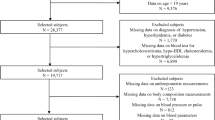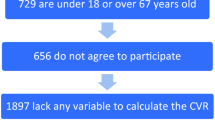Abstract
OBJECTIVE: To determine the cut-off points of indices of obesity for detecting hypertension, dyslipidemia and diabetes mellitus in Japanese individuals.
DESIGN: Cross-sectional study.
SUBJECTS: A total of 2728 Japanese individuals (768 males and 1960 females, aged 20–79 y) who attended the Fukuoka Health Promotion Center, Japan for health check-up.
MEASUREMENTS: Body mass index (BMI), waist circumference (WC) and waist-hip ratio (WHR) were measured. Percentage fat mass (%FM), trunk fat mass (FMtrunk) and trunk fat mass–leg fat mass ratio (FMtrunk/FMlegs) were obtained by dual-energy X-ray absorptiometry (DXA). Cardiovascular risk factors were determined by blood pressure, serum lipids, fasting blood glucose and hemoglobin A1C.
RESULTS: The cut-off points of BMI, WC and WHR were around 23.5 kg/m2, 84 cm and 0.9 for males, and 22.5 kg/m2, 72 cm and 0.8 for females. The cut-off points of %FM, FMtrunk and FMtrunk/FMlegs were around 24%, 8 kg and 1.6 for males, and 35%, 9 kg and 1.4 for females. WHR and FMtrunk/FMlegs most accurately detected the risk factors.
CONCLUSIONS: For Japanese individuals, the cut-off points for detecting cardiovascular risk factors are lower than the criteria by the World Health Organization. Indices of fat distribution detected the cardiovascular risk factors more accurately than those of overall adiposity. The accuracy of detecting the risk factors was comparable between the anthropometric indices and indices obtained by DXA.
This is a preview of subscription content, access via your institution
Access options
Subscribe to this journal
Receive 12 print issues and online access
$259.00 per year
only $21.58 per issue
Buy this article
- Purchase on Springer Link
- Instant access to full article PDF
Prices may be subject to local taxes which are calculated during checkout
Similar content being viewed by others
References
World Health Organization. Obesity: preventing and managing the global epidemic. Report of a WHO Consultation on Obesity. WHO Technical Report Series No. 894. WHO: Geneva; 1998.
Smalley KJ, Knerr AN, Kendrick ZV, Colliver JA, Owen OE . Re-assessment of body mass indices. Am J Clin Nutr 1990; 52: 405–408.
Roubenoff R, Dallal GE, Wilson PWF . Predicting body fatness: the body mass index vs estimation by bioelectrical impedance. Am J Public Health 1995; 85: 726–728.
Curtin F, Morabia A, Pichard C, Slosman DO . Body mass index compared to dual-energy X-ray absorptiometry: evidence for a spectrum bias. J Clin Epidemiol 1997; 50: 837–843.
Deurenberg P, Yap M, van Staveren WA . Body mass index and percent body fat: a meta analysis among different ethnic groups. Int J Obes Relat Metab Disord 1998; 22: 1164–1174.
Gallagher D, Heymsfield SB, Heo M, Jebb SA, Murgatroyd PR, Sakamoto Y . Healthy percentage body fat ranges: an approach for developing guidelines based on body mass index. Am J Clin Nutr 2000; 72: 694–701.
He M, Tan KC, Li ET, Kung AW . Body fat determination by dual energy X-ray absorptiometry and its relation to body mass index and waist circumference in Hong Kong Chinese. Int J Obes Relat Metab Disord 2001; 25: 748–752.
Ito H, Ohshima A, Ohto N, Ogasawara M, Tsuzuki M, Takao K, Hijii C, Tanaka H, Nishioka K . Relation between body composition and age in healthy Japanese subjects. Eur J Clin Nutr 2001; 55: 462–470.
Ellis KJ . Human body composition: in vivo methods. Physiol Rev 2000; 80: 649–680.
Walton C, Lees B, Crook D, Worthington M, Godsland IF, Stevenson JC . Body fat distribution, rather than overall adiposity, influences serum lipids and lipoproteins in healthy men independently of age. Am J Med 1995; 99: 459–464.
Rosenfalck AM, Almdal T, Gotfredsen A, Hilsted J . Body composition in normal subjects: relation to lipid and glucose variables. Int J Obes Relat Metab Disord 1996; 20: 1006–1013.
Rissanen P, Hamalainen P, Vanninen E, Tenhunen-Eskelinen M, Uusitupa M . Relationship of metabolic variables to abdominal adiposity measured by different anthropometric measurements and dual-energy X-ray absorptiometry in obese middle-aged women. Int J Obes Relat Metab Disord 1997; 21: 367–371.
Paradisi G, Smith L, Burtner C, Leaming R, Garvey WT, Hook G, Johnson A, Cronin J, Steinberg HO, Baron AD . Dual energy X-ray absorptiometry assessment of fat mass distribution and its association with the insulin resistance syndrome. Diabetes Care 1999; 22: 1310–1317.
Tatsukawa M, Kurokawa M, Tamari Y, Yoshimatsu H, Sakata T . Regional fat deposition in the legs is useful as a presumptive marker of antiatherogenesity in Japanese. Proc Soc Exp Biol Med 2000; 223: 156–162.
Wu CH, Yao WJ, Lu FH, Wu JS, Chang CJ . Relationship between glycosylated hemoglobin, blood pressure, serum lipid profiles and body fat distribution in healthy Chinese. Atherosclerosis 1998; 137: 157–165.
Chang CJ, Wu CH, Lu FH, Wu JS, Chiu NT, Yao WJ . Discriminating glucose tolerance status by regions of interest of dual-energy X-ray absorptiometry. Clinical implications of body fat distribution. Diabetes Care 1999; 22: 1938–1943.
Sakurai Y, Kono S, Shinchi K, Honjo S, Todoroki I, Wakabayashi K, Imanishi K, Nishikawa H, Ogawa S, Katsurada M . Relation of waist–hip ratio to glucose tolerance, blood pressure, and serum lipids in middle-aged Japanese males. Int J Obes Relat Metab Disord 1995; 19: 632–637.
Ko GTC, Chan JCN, Woo J, Lau E, Yeung VTF, Chow C-C, Wai HPS, Li JKY, So W-Y, Cockram CS . Simple anthropometric indexes and cardiovascular risk factors in Chinese. Int J Obes Relat Metab Disord 1997; 21: 995–1001.
Umeda T, Kono S, Sakurai Y, Shinchi K, Imanishi K, Nishikawa H, Ogawa S, Katsurada M, Wakabayashi K, Honjo S, Todoroki I . Relationship of cigarette smoking, alcohol use, recreational exercise and obesity with serum lipid atherogenicity: a study of self-defense officials in Japan. J Epidemiol 1998; 8: 227–234.
Ko GT, Chan JC, Cockram CS, Woo J . Prediction of hypertension, diabetes, dyslipidaemia or albuminuria using simple anthropometirc indexes in Hong Kong Chinese. Int J Obes Relat Metab Disord 1999; 23: 1136–1142.
Deurenberg-Yap M, Chew SK, Lin VFP, Tan BY, van Staveren WA, Deurenberg P . Relationships between indices of obesity and its co-morbidities in multi-ethnic Singapore. Int J Obes Relat Metab Disord 2001; 25: 1554–1562.
Ito H, Ohshima A, Inoue M, Ohto N, Nakasuga K, Kaji Y, Maruyama T, Nishioka K . Weight reduction decreases soluble cellular adhesion molecules in obese women. Clin Exp Pharmacol Physiol 2002; 29: 399–404.
Joint National Committee on Prevention, Detection, Evaluation, and Treatment of High Blood Pressure. The sixth report of the Joint National Committee on Prevention, Detection, Evaluation, and Treatment of High Blood Pressure. Arch Intern Med 1997; 157: 2413–2446.
Expert Panel on Detection, Evaluation, and Treatment of High Blood Cholesterol in Adults. Summary of the second report of the National Cholesterol Education Program (NCEP) Expert Panel on Detection, Evaluation, and Treatment of High Blood Cholesterol in Adults (Adult Treatment Panel II). JAMA 1993; 269: 3015–3023.
Hata Y, Mabuchi H, Saito Y, Itakura H, Egusa G, Ito H, Teramoto T, Tsushima M, Tada N, Oikawa S, Yamada N, Yamashita S, Sakuma N, Sasaki J . Report of the Japan Atherosclerosis Society (JAS). Guideline for diagnosis and treatment of hyperlipidemia in Japanese adults. J Atheroscler Thromb 2002; 9: 1–27.
Itakura H, Matsuzawa Y, Kita T, Mabuchi H, Matsuzaki M, Nakaya N, Oikawa S, Saito Y, Sasaki J, Shimamoto K . J-LIT [Japan Lipid Intervention Trial]. Nippon Rinsho 2001; 59: 462–468. (Japanese).
Kuzuya T, Nakagawa S, Satoh J, Kanazawa Y, Iwamoto Y, Kobayashi M, Nanjo K, Sasaki A, Seino Y, Ito C, Shima K, Nonaka K, Kadowaki T . Report of the Committee on the classification and diagnostic criteria of diabetes mellitus. Diabetes Res Clin Pract 2002; 55: 65–85.
Hanley JA, McNeil BJ . The meaning and use of the area under a receiver operating characteristic (ROC) curve. Radiology 1982; 143: 29–36.
Dobbelsteyn CJ, Joffres MR, MacLean DR, Flowerdew G . A comparative evaluation of waist circumference, waist-to-hip ratio and body mass index as indicators of cardiovascular risk factors. The Canadian Heart Health Surveys. Int J Obes Relat Metab Disord 2001; 25: 652–661.
Ministry of Health and Welfare. National Survey of Circulatory Disorders 1990. Cardiovascular Research Foundation: Suita, 1993 (abstract in English).
Ohmura T, Ueda K, Kiyohara Y, Kato I, Iwamoto H, Nakayama K, Nomiyama K, Ohmori S, Yoshitake T, Shinkawu A, Hasuo Y, Fujishima M . Prevalence of type 2 (non-insulin-dependent) diabetes mellitus and impaired glucose tolerance in the Japanese general population: the Hisayama Study. Diabetologia 1993; 36: 1198–1203.
Sekikawa A, Eguchi H, Tominaga M, Igarashi K, Abe T, Manaka H, Sasaki H, Fukuyama H, Kato T, Kiyohara Y, Fujishima M . Prevalence of type 2 diabetes mellitus and impaired glucose tolerance in a rural area of Japan. The Funagata diabetes study. J Diabetes Compl 2000; 14: 78–83.
Acknowledgements
The authors are grateful to the staff members of the Fukuoka Health Promotion Center for their contribution to this project.
Author information
Authors and Affiliations
Corresponding author
Rights and permissions
About this article
Cite this article
Ito, H., Nakasuga, K., Ohshima, A. et al. Detection of cardiovascular risk factors by indices of obesity obtained from anthropometry and dual-energy X-ray absorptiometry in Japanese individuals. Int J Obes 27, 232–237 (2003). https://doi.org/10.1038/sj.ijo.802226
Received:
Revised:
Accepted:
Published:
Issue Date:
DOI: https://doi.org/10.1038/sj.ijo.802226
Keywords
This article is cited by
-
Disparity in Obesity and Hypertension Risks Observed Between Pacific Islander and Asian American Health Fair Attendees in Los Angeles, 2011–2019
Journal of Racial and Ethnic Health Disparities (2023)
-
Body fat percentage cutoffs for risk of cardiometabolic abnormalities in the Chinese adult population: a nationwide study
European Journal of Clinical Nutrition (2018)
-
Optimal cut-off of obesity indices to predict cardiovascular disease risk factors and metabolic syndrome among adults in Northeast China
BMC Public Health (2016)
-
Optimal waist circumference cut-off points and ability of different metabolic syndrome criteria for predicting diabetes in Japanese men and women: Japan Epidemiology Collaboration on Occupational Health Study
BMC Public Health (2016)
-
The association of fasting blood glucose (FBG) and waist circumference in northern adults in Iran: a population based study
Journal of Diabetes & Metabolic Disorders (2014)



